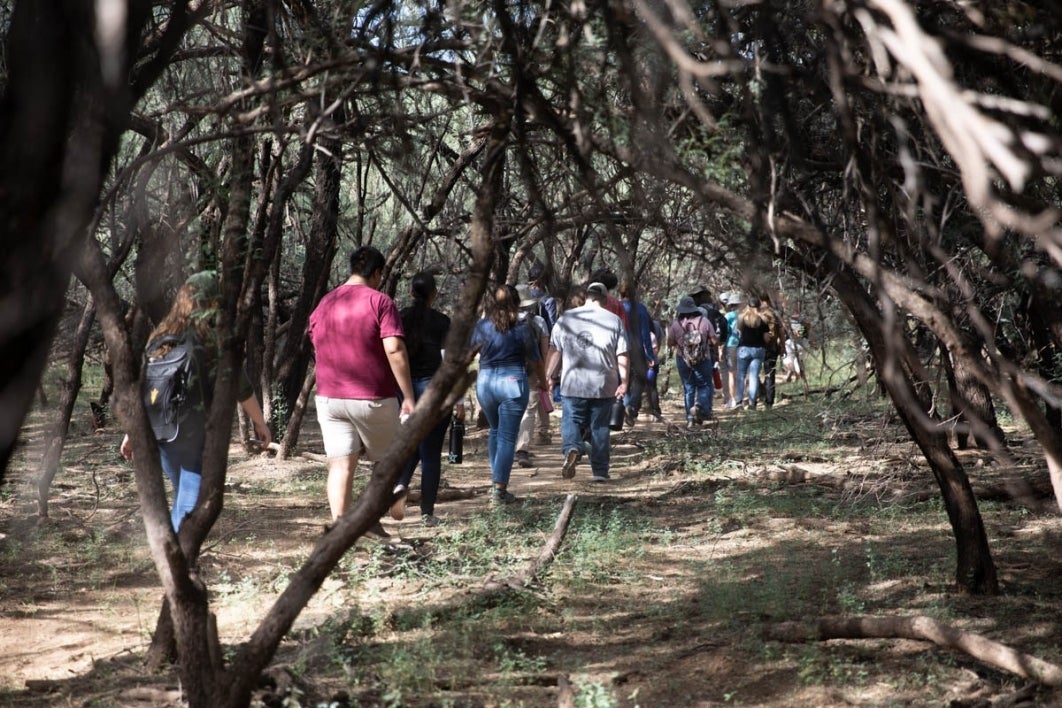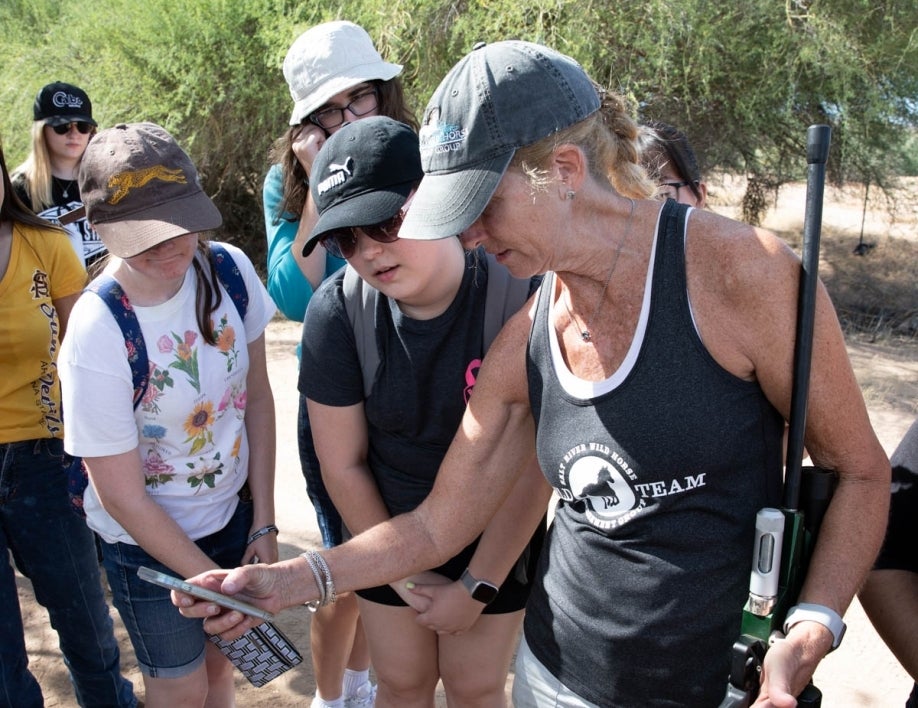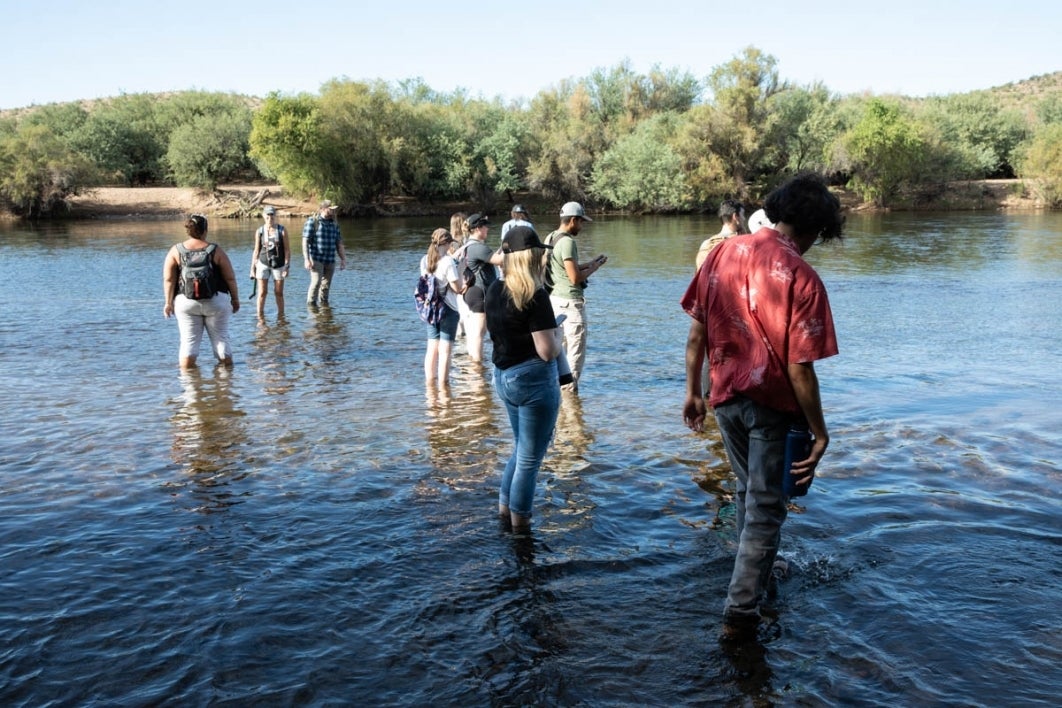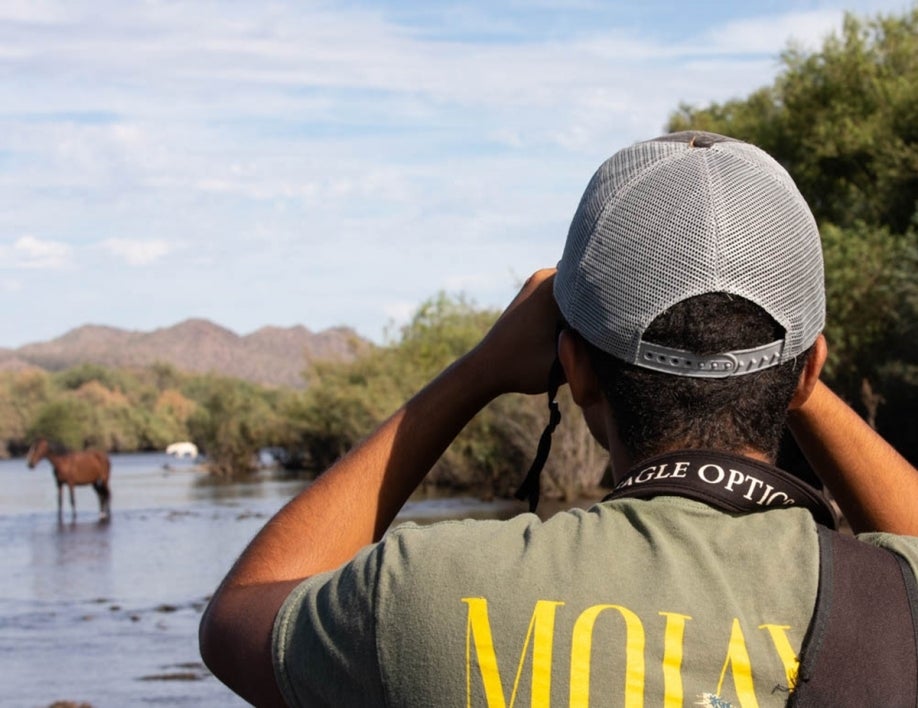On a Friday afternoon, in a dusty desert area known as Coon Bluff, students hiked through a maze of mesquite trees to the Lower Salt River in Mesa, Arizona. There, in the distance, was a group of wild horses.
The students are enrolled in Arizona State University’s pre-veterinary medicine program, which prepares them for vet school or other related careers. The field trip takes place every semester as part of the curriculum for ASU's wildlife management and captive-animal behavior management classes.
The experience is both exciting and educational.
“It was helpful to see them in the wild,” said Aubri Chapman, a third-year pre-vet student on the trip. “I think it was neat to see how socialized they were for wild horses.”
Indeed, the majestic horses grazed in the river against the backdrop of Stewart Mountain and Arizona’s blue skies. It was the perfect setting for a plein airPlein air painting is the act of painting outdoors. painter.
Students quietly waded into the river and then stood, as still as the horses, knowing that one cough, careless comment or click might startle them and break the spell of the moment.
Taking the class on the road
These horses, along with nearly 430 others, make their home in the Tonto National Forest. They are documented in the area as far back as 1890.
Julie Murphree has taken her students to the Salt River since 2017, in part because she says traditional textbooks used to train future wildlife managers lack information related to wild horses.
She said the outings give students a chance to observe the behavior of wild horses, understand fertility plans that are in place and by the end of the day hopefully gain more clarity about their career path.
“Getting out in the field affords students the opportunity to learn much more than they could in the classroom,” said Murphree, an animal science and wildlife lecturer at ASU’s College of Integrative Sciences and Arts. “They not only witness, firsthand, the unique social dynamics and foraging behavior of the Salt River horse bands, they also assess the condition of the Salt River riparian area (the banks of the river) where the wild horses roam.”
The mystique of the mustang
Murphree’s passion for horses began as a child on her great-grandfather's farm and grew over the years. She understands how the evolving views of wild horses have impacted wildlife management policies.
There has been a shift, Murphree explained, in how wild horses were viewed over time — from being regarded as functional livestock to being considered highly intelligent animals, akin to a family pet. The values placed on horses determine how they will be treated.
Murphree says the mystique of the mustang draws tourists from all over the world to the Lower Salt River.
“There is a special role that horses play in the history of America. The West was won on the back of a horse, so people want to see them wild and free. ... That’s part of the draw to this area.”
Reining in the population
Back at the river, the Salt River Wild Horse Management Group were contributing to the lessons of the day.
The nonprofit rescues injured wild horses and monitors them daily. The volunteers have hand-counted each horse in the area and created an app to document every birth, death, injury and more — in order to track and protect them.
They have even named all of the horses roaming the 19,000-acre area — there’s Serta, Minnie, Mirabelle, Makenzie and more.
The group taught students about the different, and sometimes divisive, management tactics that have been used to reduce the herd in the past.
Over the years, without adequate numbers of large predators such as mountain lions or wolves, the wild horse population has rapidly grown, doubling over each five-year period. And the fenced-in area has limited the space available for more horses.
Historically, the perceived overabundance of wild horses was handled with major roundups that caused concern and conflict over the fate of the animals. In 2016, the Salt River Wild Horse Management Group helped establish the Salt River Wild Horse Act, which states that the horses that are part of the Salt River horse herd are not livestock and are protected by law.
“At that point, we were given the ultimatum to either have the horses rounded up or reduce their population,” said Destini Rhone, chief of operations for the Salt River Wild Horse Management Group.
They opted for the latter. The organization was charged by the state with managing the horse population.
Now, volunteers administer birth control that is darted in the field without needing to capture the horses — a process that was demonstrated for the students.
ASU alum makes the range her second home
Makenzie Gleave, who was on hand as a wild-horse liaison for the day, used to be just like the students she was now assisting on the field trip.
Gleave was enrolled in ASU’s pre-veterinary program for two years and graduated with a degree in applied biology in 2014.
Now, she spends many days hiking and horseback riding in the area in order to track down hurt or lost horses and observe their behavior and social structure.
She said her ASU education helped secure her current position as liaison and livestock manager for the Arizona Department of Agriculture.
Murphree says she uses these field trips and the engagement with community partners to demonstrate the multitude of career paths available to graduates once they enter the workforce.
“Students are provided with the opportunity to find their niche,” she said.
Takeaways from the day
With the sunset slowly approaching, horses prepared to bed down on the bank of the river and students began their trek back to their cars.
Daniela Soto Cabrera, a graduate student under the supervision of Murphree, emerged from the river with a bouquet of eelgrass — the food horses graze on in the water. She had pulled the grass from the riverbed and stuck it in a plastic bottle for further study.
“It’s not just an adventure — it’s an opportunity to talk to officials in different departments,” Cabrera said. “It is very eye-opening for students still indecisive about their future careers in animal care.”
Top photo: Wild horses wade in the Salt River in Mesa, Arizona, on Oct. 14. Photo by Ken Fagan/ASU News
More Science and technology

The Polytechnic School at ASU hits milestone mark at 10 years
The year was 2014.Taylor Swift released “1989.” "Frozen” and its soundtrack were stuck in the minds of many.Facebook was still the most popular social media site, and “Happy” by Pharrell…

Study finds cerebellum plays role in cognition — and it's different for males and females
Research has shown there can be sex differences between how male and female brains are wired.For example, links have been made between neurobehavioral diseases — such as attention-deficit/…

Artificial intelligence drives need for real data storage innovations
In southeastern Mesa, Arizona, construction crews are hard at work on a state-of-the-art data center. The $1 billion facility will open in 2026 and provide approximately 2.5 million square feet…





